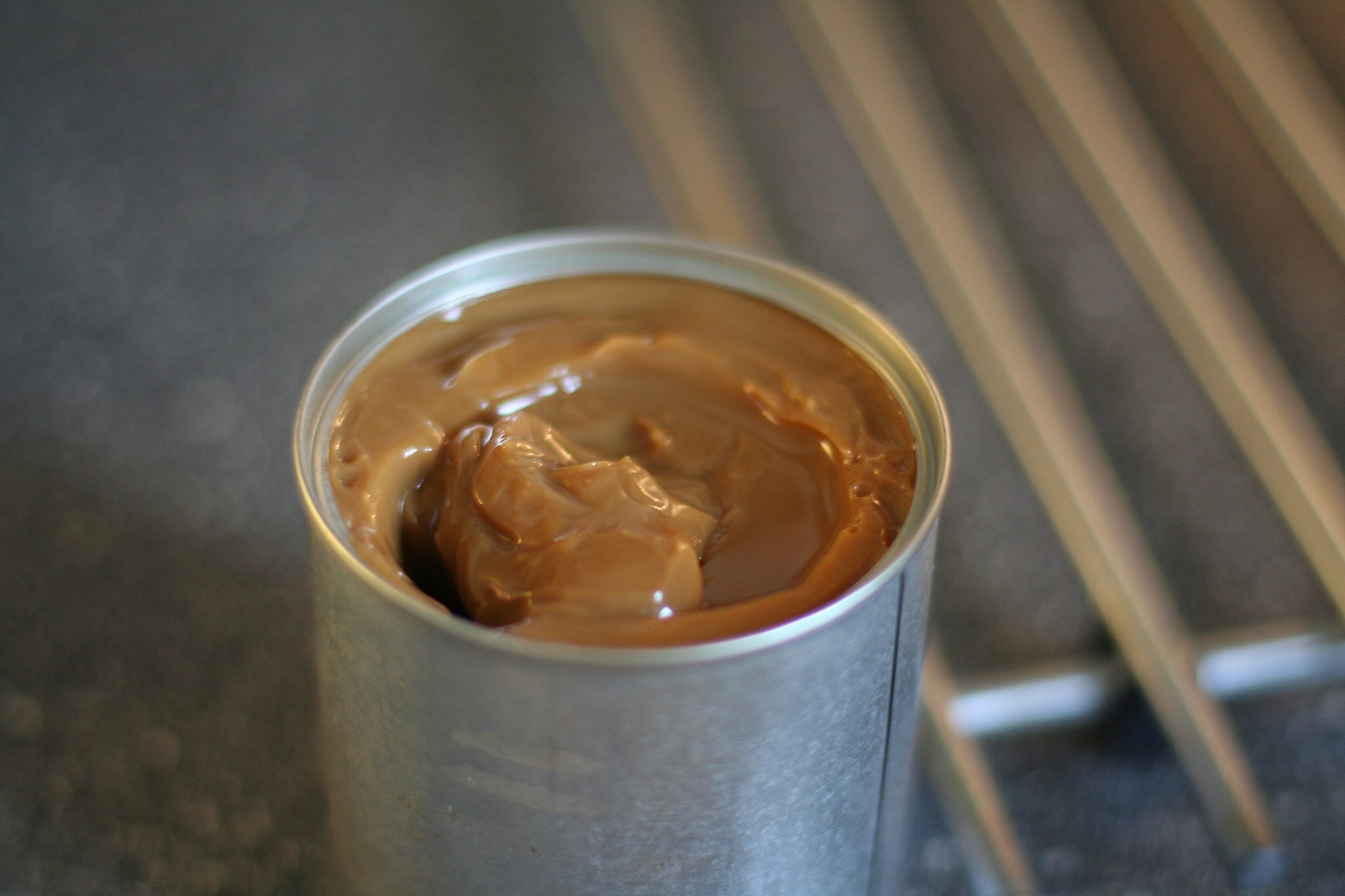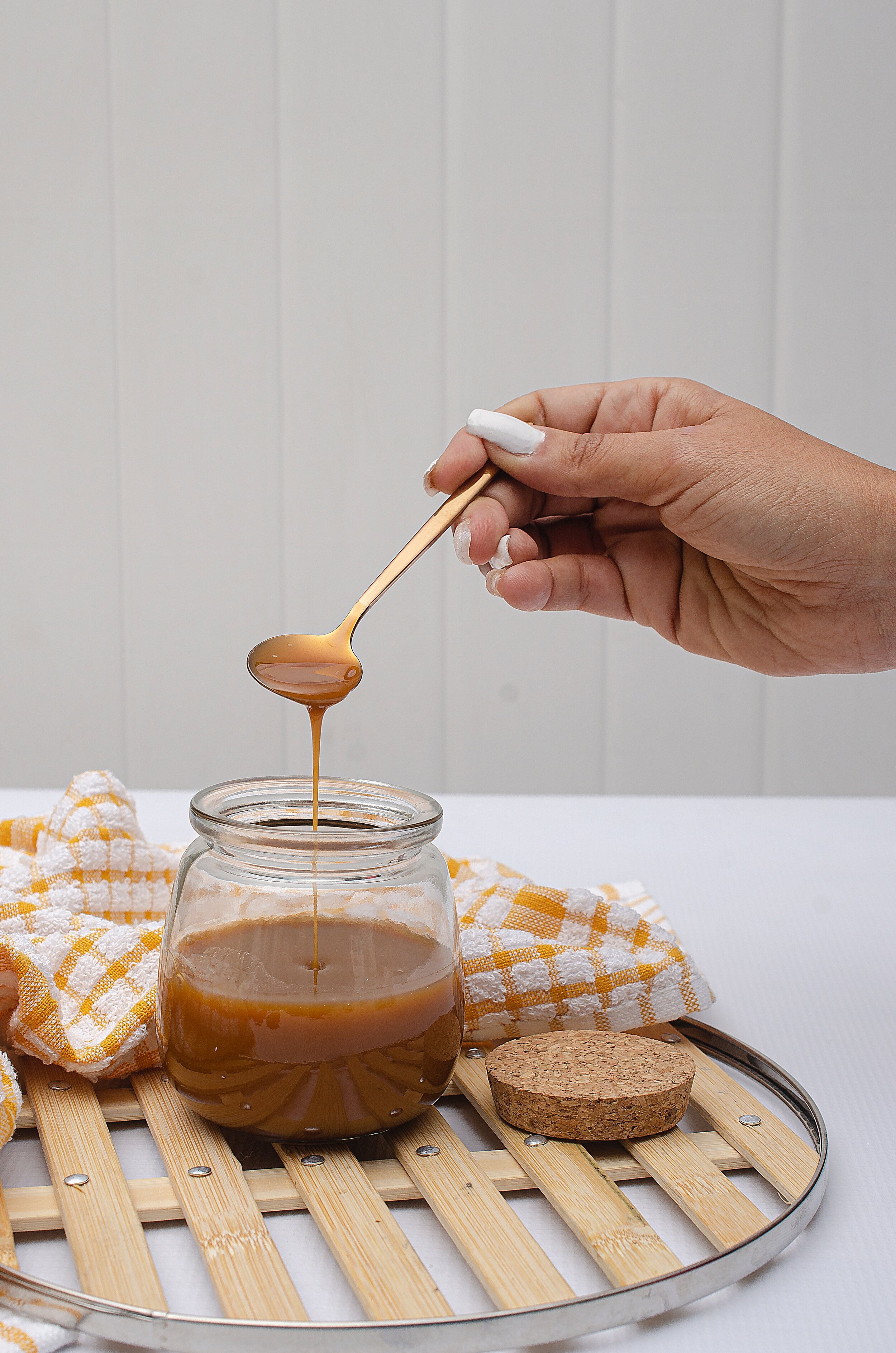An Ode to Dulce de Leche
By Vinka Danitza Woldarsky
Sweetened condensed milk boiled in a can serves as a midpoint between scratch-made and store-bought dulce de leche. Photo by Christer Edvartsen, CC BY 2.0, via Wikimedia Commons.
Growing up in Winnipeg, Canada, my house was the only one out of all my friends’ where it wasn’t uncommon to walk into the kitchen and see unlabeled cans bobbing in a pot of boiling water with a slice of lemon. The brown lemon peel and the stained rim on the side of the pot indicated that the cans were just about ready.
Soon they would reveal their sweet content, and we’d be given the empty cans to scrape out the leftovers.
What would once make me cringe with embarrassment, those cans boiling in hot water, now makes me giggle. I still catch my mom doing it.
“You don’t have to do that anymore,” I tell her. “You can buy dulce de leche at the store.”
She looks at me, looks at the cans, shakes her head and says, “It’s not the same.” Her sweet smile has an innocence and excitement that reminds me of childhood.
***
Dulce de leche is practically part of my DNA, it runs through my veins, but I’ve never made it from scratch. That process involves people, mostly women, working over a hot pot of milk, sugar and vanilla to produce the sweet spread, stirring endlessly for hours to make sure the milk didn’t burn, boil or clump. Decades have passed since that was standard.
The reality is that there really was never any need to make it. It has always been available in some form, whether that was directly from the grocery store when I was a child in Chile or through the glamourous technique of cooking condensed milk cans once we immigrated to Canada in the 1980s.
After the onset of industrialization in Latin America in the early 1900s, the luxury item that was dulce de leche became a commodity by the middle to end of the century. Within a short span of time, kids went from licking wooden spoons and scraping the leftovers out of large copper pots that were once used to make dulce de leche, to scraping out condensed milk cans and then plastic tubs or jars of the branded stuff in the 1980s and ’90s.
Generations of kids, from Mexico to Uruguay, no longer know the “family secret” or their abuela’s way of making dulce de leche because, like me, there just wasn’t any need for them to know its preparation, its source or its story.
But dulce de leche is quintessentially Latin American. It is found in just about every country, changing names as it crosses borders but varying little in taste and composition. In Colombia, they call it arequipe; in Peru, manjar blanco; in Cuba, fanguito; in Brazil, doce de leite; in Mexico, cajeta (made from goat’s milk); in Chile, manjar; and of course, dulce de leche in the rest of the region.
A source of joy and happiness for kids and adults alike, dulce de leche is in just about every dessert, cake or cookie. It is found layered in puff pastry, piped into donut-like fried dough, coating entire cakes, placed on top, on the bottom and in between black and white chocolate wafers.
The Argentine chocotorta and the Brazilian brigadeiro are proof that the sweet, intense flavors of chocolate and dulce de leche can coexist in one delicious dessert. Chileans and Peruvians tend to layer it with meringue, demonstrating like our neighbors that too much sugar in one bite is not a bad thing.
Dulce de leche can be hard, baked and cut into large slabs, with a crusted exterior that gives way to a smooth interior, sometimes with crunchy sugar crystals that haven’t quite dissolved such as in the La Vaquita tablets. Or it can be made into soft candy, like the Chilean Calugones Pelayo (now sadly discontinued); when you bit into one, you would see your teeth marks and the chewy, stringy caramel that stretched out on each side was like cheese on a pizza.
Dulce de leche can be spread on toast for a nutritious breakfast or snack (so the advertisements tell us), and there are infinite versions of dulce de leche ice cream. But the most authentic way to eat dulce de leche is by the spoonful. A no-fuss, no-recipe-required way to taste a product that appeared in our lives rather out of the blue.
***
Despite the fact that the famous Latin American dessert/topping/spread is a source of national pride and identity for Argentines and Uruguayans, who in 2003 wanted to declare it UNESCO World Heritage of Gastronomic Culture, it seems to have no real “story” of its birth or its travels to and from Latin America. A whole continent feels affinity (passion, if you will) toward this sweet spread, but its history has been lost and replaced by dubious legends, folktales and anecdotes of how it could have come to be.
Some say that it travelled by ship centuries ago, probably from the Philippines, Indonesia or India in the hands of Spanish conquistadores who then brought it to the Americas. Others say it spread through the continent during the Wars of Independence in the 1800s. I know for a fact that it traveled in planes to North America in the 1980s and ’90s, smuggled in the suitcases of Chilean exiles, those longing for the taste of home.
One thing is for sure: The anglicized pronunciations that can be overheard at restaurants and cafes indicate how, in the last 20 years, it has become a mainstream product. That may be a source of bittersweet pride for most South Americans because, yes, there was a time when it was an arduous quest to find it. Even its alternative, condensed milk, could only be found in Asian grocery stores with brand names like Eagle or Carnation written in Chinese characters. You had to hope you were buying condensed milk and not evaporated milk, a similar product but one that does not make dulce de leche when you cook it.
Dulce de leche is an immigrant like many of us. It struggled to make a home, to be accepted, to belong, but it’s now fully established and found on the shelves of North American grocery stores, usually beside the Nutella or other chocolate spreads and often renamed as a “sweet caramel spread.”
Still, every time I see it at the store or an ice cream shop, I have to buy it and try it. It’s a reflex of sorts. And yet, I know I’ll be slightly disappointed. Like my mother, I feel like “it’s just not the same.” It will be too sweet or too thin, too gooey, too artificial or just caramel masquerading as the real thing. It will lack depth of flavor, and the smooth, rich milkiness that coats the mouth but isn’t cloying or difficult to swallow.
***
Dulce de leche has always been the protagonist in every birthday cake and bite-sized treat on special occasions. Photo by DRAKE NICOLLS from Pexels.
A few weeks ago, I decided to do the unexpected. I rolled up my sleeves and began to make it, but not like my mother had made it, nor like my grandmother had made it, because that connection and culinary tradition has long vanished.
With food, there is always the talk of traditions. Recipes, techniques and knowhow are usually passed down from generation to generation. But that’s not my case. In my very first attempt to make the iconic spread, I improvised, like an uninstructed student, relying solely on curiosity and a desire to reconnect to a past long forgotten. Because dulce de leche has always been the protagonist in every birthday cake and bite-sized treat on special occasions, it must have a story to tell, I thought.
I placed the four ingredients into a pot: milk, sugar, vanilla and a pinch of baking soda. The heat was on low, and as I began to stir, waiting for the sugar to dissolve, the milk to thicken, watching as the contents swirled around the pot, my Chilean manjar spoke to me.
It told me the story of how my mother, resilient and clever, made my sisters and I manjar sandwiches when we moved to Canada. She would label them “peanut butter sandwiches” so that we wouldn't feel embarrassed or left out. It also told me of how she ate manjar by the spoonfuls when milk was available during Allende’s presidency from 1970 to ’73. His policy to combat child malnutrition with a “half a litre of milk a day” for all Chilean children, regardless of social or economic class, allowed all sorts of milk-based desserts to flourish in her house when she was a teenager.
It told me how in the months leading up to the coup, the milk ran scarce, the sugar disappeared, in fact, many products just couldn’t be found as supporters of Pinochet’s dictatorship hoarded household items. And when Pinochet finally seized power, the milk stopped, the desserts ended, and the bliss of eating sweet manjar was forgotten in the dark haze of the dictatorship.
My Chilean manjar told me how my grandmother, Juanita—a woman who was known to dance and laugh, who would make manjar from Nestle’s La Lechera condensed milk—could hardly get out of bed after the coup, let alone cook anything. Her heart was broken and shattered by the violence that entered the house, by seeing her 9-year-old son held at gunpoint by the military. No amount of manjar would ever be sweet enough to erase those bitter memories.
It told me of my great grandmother, Rosalia, one of the last women in our family who used to make manjar from scratch. In her time, the milk that would have been accessible to working-class families like hers was powdered. The sugar would have been dark cane sugar from Cuba or Brazil, and only available on special occasions. The vanilla, priced like gold, was just nonexistent. Rosalia would roll up her sleeves and spend hours stirring, waiting for the sugar to dissolve, the milk to thicken and imparting pieces of progressive wisdom to her granddaughters.
“Husbands only cause trouble,” she would say. “It’s better just to have lovers.” Manjar was such a rarity then, a sacred treasure, just like it used to be for me as a child in Canada.
After three hours of stirring, my manjar was ready. I anxiously let it cool and finally dipped my teaspoon and tasted it. It was sweet, it was smooth, it coated my mouth. But it was delicate and distinct from the concentrated condensed milk or store-bought stuff. The caramelized sugar, the thickened milk and the vanilla aromas were subtle, timid at first but in time, slowly began to reveal layers of flavor unlike any dulce de leche I had ever tried. It was a blissful experience.
I felt a little baby kick in my belly and I knew my daughter would love it just like me.
This manjar has yet another story to tell, I thought. This time my story, but not one of recipes or elaborate desserts, one as an immigrant woman who through the process of stirring milk and sugar brought to life another piece of her story, of immigration, of healing, of belonging.
If Pablo Neruda, the Chilean poet and Nobel Laureate, wrote poems in praise of tomatoes, lemons, bread and wine in his collection of Odes to Common Things, it must have slipped his mind to write “Ode to Manjar” or “Ode to Dulce de Leche.” Surely, he would have written about its travels from faraway places, the joy and laughter it brought children or its absence on store shelves.
Or maybe, like most of us, he never noticed that behind the hours of stirring milk and sugar, there are endless stories waiting to be heard.


